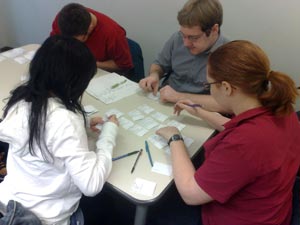Evil Genius VS Spies


Project Goals
We set out to create an asymmetric card game that was well balanced and included interesting game mechanics that dealt with the spatial relationships between cards. The game mechanics and complexity found in Evil Genius VS Spies is comparable to other card games in the CCG genre.
The essential experience revolves around making the players feel like they were an Evil Genius or a crafty Spy Master. Our game mechanics were inspired by the tropes found in the spy thriller genre.
Team Contributions
Creating this game really was a team effort. We held at least one meeting a week where everyone worked together to develop and test the game design. As a result, there was no designated interaction designer on our team.
Eric took the role of project manager, organizing and assigning tasks. In addition, he was in charge of creating the website layout, some card art, part of the presentation, and this development report. Brooklyn created all of the card layouts and some card art. Mark created the rule book and the sample game showed in the presentation. He also ran the external playtesting sessions and final editing for the text on the cards. Vivian was the lead artist who set the art style and created early concept art. Her focus for card art was minions and spies as they are the focus of the game. Jesse and Jun both created a large amount of card art.
Developing the Game Mechanics
We tried our best to document the many different iterations we went through in reaching our final design. We did a lot of playtesting ourselves to refine the mechanics until we reached a point where it felt balanced and fun to play.
The Original Idea:

Creating the decks used for playtesting.
It took us five hours of brainstorming to choose a theme and direction we wanted to go. A few days later we met for an intense brainstorming session to come up with all the game mechanics. The original iteration of the Spy Master played completely different than the final version, with Scientists being used as resources to limit how many Nodes, Spies, and connections could be played. The early design also allowed the Evil Genius' side to build multiple lairs and to send minions to attack the Spy Master's networks. Both mechanics that were ultimately discarded. The combat mechanics had not been worked out at this point so the game was not very playable.
Major Revision:
It took us an additional four hours to refine the original idea such that it would be playable. Unfortunately, combat didn't feel fun at all and we knew we would need to continue to make some large changes to our design.
The Largest Revision:

Jesse and Jun playtesting the game.
It took us around 14 hours to complete spread over two days. One of the key problems we identified was that there were a lot of cards that did not do anything interesting and needlessly took up space in the deck. The Scientists were the biggest offender, as they added nothing more to the gameplay other than being used as a resource, so we took them out and added more Nodes and Spies in their place. This required us to completely change the cost mechanics for Nodes and Spies, which changed the gameplay of the Spy Master substantially. Instead of relying on using Scientist cards as a resource, we decided to add a minimum and maximum network size to each spy and to the network bonuses provided by the Nodes. Doing so allowed us to limit growth in the same way that the Scientists did without needing to add an extra card type to do so. The Evil Genius' Research cards had a similar problem so we replaced them with Contraptions that could provide individual bonuses to minions or have a stronger spatial relation to where they were played in the Evil Lair.
Tuning:
After doing a round of external playtesting, we spent eight hours on a final tuneup session of the gameplay using the feedback we were provided. It mostly involved making overpowered cards more balanced and simplifying some cards. In the end the game felt balanced and really fun to play.
Playtesting
CCG almost always have a steep learning curve due to the complexity of their rules, and Spies VS Evil Genius is no exception. In fact, the most popular CCG, Magic: The Gathering, recommends that players first watch a few games between more experienced players before even reading the rule book. As a result, we felt it was necessary to take the time to explain the rules in detail during out external playtesting sessions. However, we made a conscious effort not to discuss strategies with the players so that we could observe what they came up with on their own. At the heart of the game, it is these strategies which drive the gameplay and is what we really wanted to test.
Two members of the SFU Game Developers Club spent roughly 1.5 hours playing a paper prototype of our game. After the testing session was complete, we interviewed them on their experience with the game. Since the participants did not have much experience playing other CCGs, we were very interested to see how players unaccustomed to the CCG genre would approach the complexities in the gameplay.
We were a bit surprised that players did not use strategies we came up with, although this is to be expected in playtests. The Evil Genius played a Steel Door not at the front of the lair as expected, but in the middle of the lair instead. The Spy Master infiltrated the lair and was able to get past everything up until the Steel Door, which with the given rules would have resulted in an irresolvable scenario. The Spy Master was able to skip over the Steel Door using Rocket Shoes, so this situation was thankfully avoided during the testing session. As a result of seeing this potential for a stalemate, we came up with a more robust rule that we could apply to the Steel Door and other obstacle Contraptions, such as the Sharks With F.R.I.C.K.E.N. Laser Beams card as well.
The Spy Master found it difficult to understand the relationship between Spies and Networks after the explanation of the rules and the player became even more confused when we explained what happened when a Spy could no longer be supported by a Network. As a result, we decided to make sure the rules were explained with more clarity in the rule book.
After the game we asked both players for general feedback and asked them questions about their experience. They both agreed that the sneaking mechanic was incredibly fun, which was in line with our own playtesting conclusions. The Evil Genius also said it was fun to knock the spies out of the Evil Lair. The biggest problem the players had was that some of the rules weren't entirely clear. What wasn't fun was choosing a new Evil Plan and drawing duplicates. The players suggested reducing the number of duplicates to make the choices more meaningful, so we made this change in our final version of the game. The Spy Master pointed out that there is no benefit for the Spy to thwart an Evil Plan the same way as when the Evil Genius completes an Evil Plan. While useful feedback, the current implementation of the game is intentionally designed this way for balancing reasons so we didn't feel making this change to the gameplay was warranted.
Using the playtesting results, we addressed as many issues as we could in our remaining time, while staying true to the core vision of the game.
Card Design
In total we created 57 unique cards that each required unique card art. When developing the card layouts we made sure to follow graphic design principles learned in other courses to create clear visual hierarchies. Both minions and spies have their stats in the same location which makes them easy to compare. Keywords and flavour text have a separate font and we use graphical symbols to represent actions whenever possible.
What Went Wrong
It took longer than we thought to come up with and refine interesting and fun game mechanics. We thought it would only take a couple of weeks to develop the core mechanics but it took us to almost the end of the project to create something that felt right. It made us realize that there was nothing except our own design abilities stopping us from making it fun.
What Went Right
Choosing to create a card game allowed us to focus on learning and practicing our design skills. As a result, this project benefitted from a lot more complexity and balance than our previous game. If we had instead decided to create this project on the computer, it would have taken valuable time away from game design and the end result would not have been as compelling.
Using plain-text, paper prototype cards allowed us to quickly test new game mechanics and stats without committing extensive hours to programming and creating game assets. Changes were often made on the spot simply by penciling in new mechanic or crossing out a mechanic that wasn't working.
The sneaking mechanic quickly became one of the most enjoyable actions of the game aside from building the evil lair. By establishing this mechanic early on we were able to use it as a reference point to base all other mechanics around.
Conclusion
We are very proud of what we were able to accomplish in our given timeframe, but (as is always the case in game design) there are still things we would like to improve upon. Ideally, Evil Genius VS Spies would be part of a larger card set where players construct their own decks using a subset of the available cards. This would be clearly out of scope of what we could achieve given our time frame.
In an effort to encourage this type of expansion on our core gameplay, we have decided to release our game under a Creative Commons license that allows people to share and modify the game as long as they acknowledge the original creators. Eric, who is President of the SFU Game Developers Club, is considering using the game as a basis for a club project where members will create expansion sets on a regular basis.
References
Some card art was artistically traced from images found on the Internet and while this took considerable time to do, we do wish to acknowledge the original sources. The original sources for the Dojo card was lost. Some of these websites have stopped hosting the files.
- "Tron" movie called "sensitive" by Homeland Security, must be pulled from shelves.(n.d.). Retrieved April 6, 2010, from http://www.dvorak.org/blog/2007/03/30/tron-movie-called-sensitive-by-homeland-security-must-be-pulled-from-shelves/
- avatar telescopic spy camera perfect for snooping on neighbors on [technabob]. (n.d.). Retrieved April 6, 2010, from http://technabob.com/blog/2009/07/29/avatar-telescopic-digital-spy-camera/
- Battalion V - Shield Generator image - Sigma Invasion Mod for C&C: Red Alert 3 - ModDB. (n.d.). Retrieved April 6, 2010, from http://www.moddb.com/mods/sigma-invasion/images/battalion-v-shieldg-enerator
- Blog 14 (30/1/07) - RA:APB and RA2:AR Official Forums. (n.d.). Retrieved April 6, 2010, from http://www.apathbeyond.com/forum/index.php?showtopic=12231
- client-server.gif (GIF Image, 310×240 pixels). (n.d.).
Retrieved April 6, 2010, from
http://code.google.com/edu/parallel/img/clientserver.gif - Security Camera Bargains | Security Camera Auction | Security Camera Tips and Tricks - Amazon Security Products. (n.d.). Retrieved April 6, 2010, from http://securitybargains.com/
- SQL Query Business Databases. (n.d.). Retrieved April 6, 2010,
from
http://www.allfreeware.com/images/full/34428-flyspeed_sql_query_business_databases___tools.gif - Wow - Eidos Forums. (n.d.). Retrieved April 6, 2010, from http://forums.eidosgames.com/showthread.php?t=85999
- Wrex Robot Dog | Kids and Baby Design Ideas. (n.d.). Retrieved April 6, 2010, from http://www.kidsbabydesign.com/toys/wrex-robot-dog/